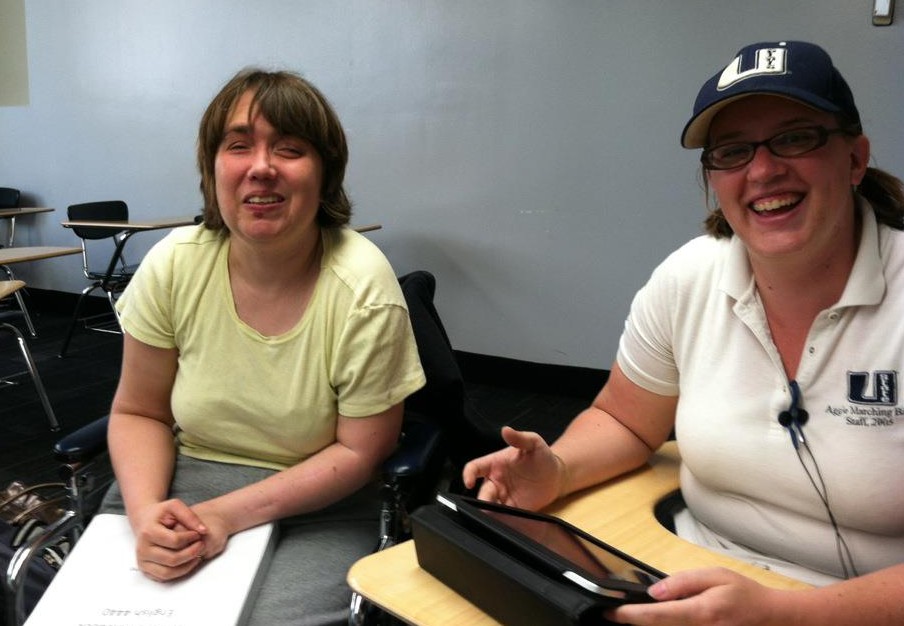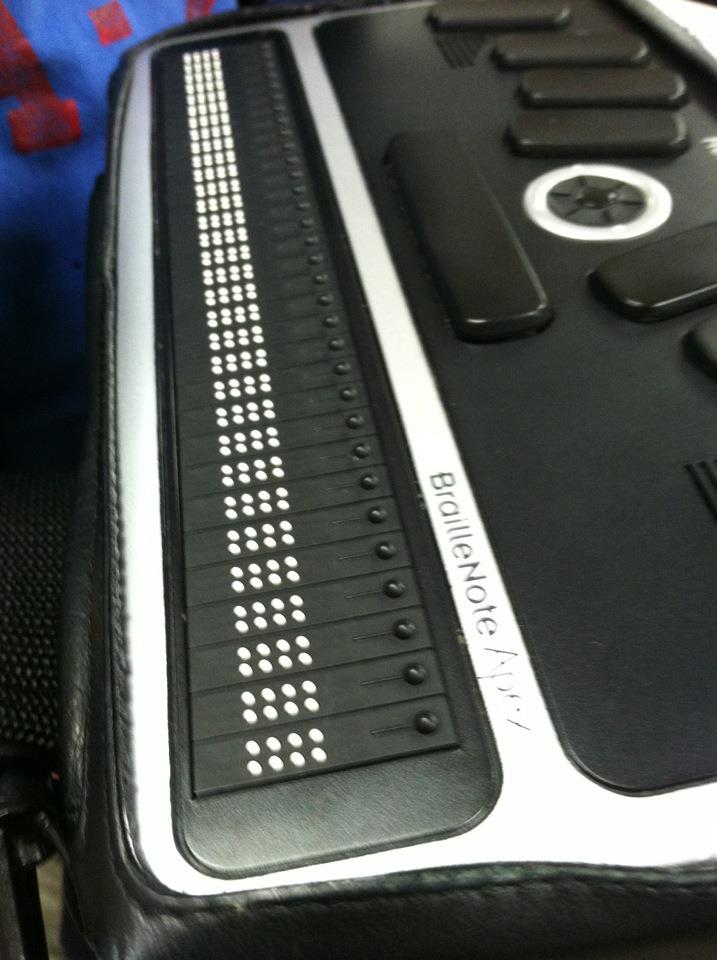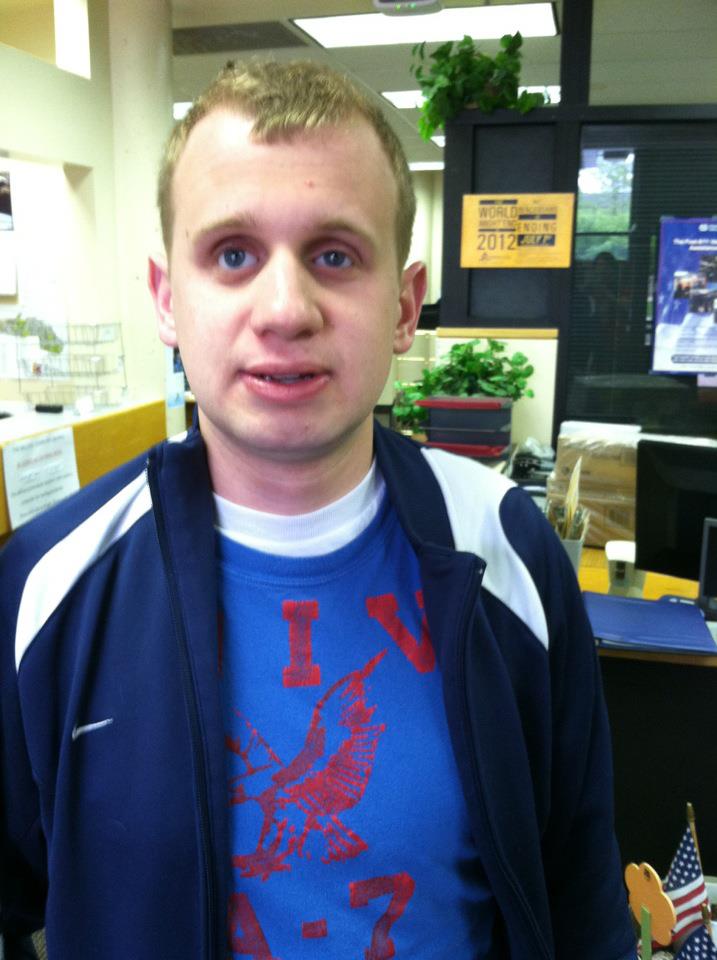Blind in a sighted world: Independence means everything
May 2nd, 2012 Posted in Arts and Life‘I decided if I wanted this I just had to go for it, and I let go of the pillar and started walking into the crowd, and nothing has been the same since.’ – Kasondra Payne
Story and photos by Chris Lee
LOGAN — At 5 a.m. every weekday morning Kasondra Payne wakes up and begins her day. She gets herself and her kids ready for school and heads over to Utah State University where she studies creative writing. She goes from class to class all day, checks her Facebook, and finishes the day with an episode of Star Trek. She does all this, nearly every day, blind.
Blind students can have a fairly normal day at the university, Payne said. People with all levels of vision loss go to class, study, and play sports, but sometimes they have to do it using different tools.
Payne has had vision problems her entire life. Even though she can still see some shapes and colors, Payne said she is very lucky she learned Braille in grade school.
“Between the 1960s and 1980s it was common not to teach kids (Braille) who were blind, if they had enough sight,” Payne said. “‘Oh you have enough sight, you can read large print, so let’s not teach you Braille.’ And that did a lot of kids a disservice.”
Payne said many of those children reached adulthood without being able to read Braille and they didn’t know how to function in the adult world. She said many blind people learned how to read Braille when they were adults because they didn’t have access to it as children.
The National Federation of the Blind (NFB), of which Payne is a member, is an organization that says it improves “blind people’s lives through advocacy, education, research, technology, and programs encouraging independence and self-confidence.” The NFB says Braille is one of the most important skills for blind people to learn for independence.
According to the NFB this is “evidenced by the relationship between Braille and employment: 80 percent of blind adults who are gainfully employed utilize Braille in their daily lives. Contrast that with the 70 percent unemployment rate among blind adults.”
Director of the USU Disability Resource Center (DRC) Diane Baum said many blind students don’t want a paper Braille textbook because they are way too massive to carry from class to class.
“Braille is very paper, and space and technology intensive,” Baum said. “Not to mention just the process of putting it into Braille. Most of our students don’t want Braille, they’d much rather have audio format.”
Even though the DRC doesn’t carry them in Braille, Baum said, the primary thing the DRC does is help blind or visually impaired students with textbooks, which students can get in audio or digital formats.
Baum said the Assistive Learning Center, located in the DRC, has technology on hand to help students who have vision loss. Technology is available for enlarging text, navigating a computer with the keyboard instead of a mouse, and audio programs to help visually impaired students.
Baum said most of the students also bring their own technology, such as a BrailleNote.
“Many of the students who are blind have their own technology,” Baum said. “A student shouldn’t have to come to campus to study. They want to study at 3 o’clock in the morning they need to have their own technology.”
To read his textbooks in Braille, history major Quinn Price said he often uses his BrailleNote. Price, who has been completely blind since early childhood, said a BrailleNote is a computer with a six-button keyboard and a strip of crystal pins that will retract to make words in Braille.
 “I use it for taking notes,” Price said. “I read a lot of electronic books on here in Braille. It also speaks if you prefer not to use Braille.”
“I use it for taking notes,” Price said. “I read a lot of electronic books on here in Braille. It also speaks if you prefer not to use Braille.”
Price said he sometimes uses the speech functions to be more efficient because he can speed up the audio. He said he generally uses Braille and not the speech function.
Reading textbooks isn’t the only thing college students do with their day. Many new students find the university difficult to navigate and learn how navigate campus with maps and landmarks. Price said blind students do the same thing.
“There’s no counting steps or anything,” Price said. “I always tell people, ‘what if you lose count, then what do you do?'”
Price said he often will use a tactile map before he goes anywhere to learn how to get from place to place. Once he knows a route he uses landmarks to guide him, just like a sighted person would. Sounds, buildings, and small drops in pavement all make good landmarks, Price said.
As everyone knows, the college experience isn’t just about the classroom. Just like many college students blind students participate in team sports. Price said he’s on the Utah Men’s GoalBall team.
GoalBall is a sport played by the blind and visually impaired, Price said. He said the court is similar in size to a volleyball court with boundaries made of thin rope taped to the floor. Players score by rolling a bell-filled ball covered in holes through their opponent’s goal.
“These three guys take this ball, and they’re standing in front of their goal, and they throw the ball underhand kind of like a bowling ball,” Price said. “The guys on the far side try and block it from going into their goal.”
Price said players from around the country compete in tournaments and blind people from around the world play GoalBall as a Paralympic sport.
Through education and athletics blind and visually impaired students can achieve great things. To be successful, people just need to have the courage to go after their goals, Payne said.
For her, one of those goals was to attend a convention for the blind.
“I got to my first convention and I was freaked out, being there with hundreds of other blind people and they were doing all of these cool things that I wasn’t, and I was sitting there clutching a pillar in the hotel lobby watching all of this go on around me,” Payne said. “I just made the decision, if I wanted this I just had to go for it, and I let go of the pillar and started walking into the crowd, and nothing has been the same since.”
NW
Tags: blind students, Diane Baum, Disability Resource Center, Kasondra Payne, Quinn Price, USU

Sorry, comments for this entry are closed at this time.